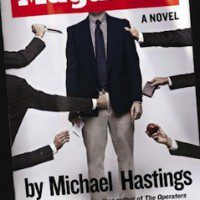It’s difficult to separate Michael Hastings’s first and final novel The Last Magazine from his life and mysterious death. The book, which takes place at a publication named The Magazine from 2002-2007 in the run-up to the wars in Iraq and Afghanistan, stars two versions of the Michael Hastings of whom the public may know. The first is also named Mike Hastings, an observant, cynical intern fresh out of college. One can imagine the second (named A.E. Peoria) as a fictional stand-in for Michael Hastings the fast-talking, fast-writing war correspondent who brought down General Stanley McChrystal with his Rolling Stone profile in 2010. The fate of the late Hastings, who died last year at 33 in a high-speed, explosive single-car crash that spawned enough conspiracy theories to clog up Twitter feeds for weeks, is considerably more tragic that anything that happens in The Last Magazine, which is a very funny, bawdy romp through the final days of the “dead tree” newsroom.
In the New York Magazine feature “Who Killed Michael Hastings?”, Benjamin Wallace wrote:
Hastings was self-aware enough to recognize he was to some degree playing a character: the swashbuckling reporter, dispatched to distant longitudes to bear witness to man’s savagery and/or idiocy. “He was very familiar with the literature and mystique of the war correspondent,” his friend Jonathan Darman says. In The Operators, Hastings’s second book, “there’s almost a double consciousness, where he identifies with the war-junkie psychology but is also critical of it.”
This double consciousness drives The Last Magazine. Peoria is the book’s most fully-realized character, operatically narcissistic, but as capable of saving the life of a soldier as he is of tearing through the lady-boy sex clubs of Bangkok without a condom. The young Mike Hastings, meanwhile, gives the reader a great view into the office politics of a weekly news magazine. One can’t help but imagine the world of Jill Abramson, struggling to navigate the giant traditional print news ship into the whitewater rapids of an increasingly online journalistic landscape.
Hastings was perhaps one of the most important journalists in the past decade because he blended insight and entertainment effortlessly. This skill is also evident in his novel, especially when he sets his sights on a skewering. In the following passage, the young Mike Hastings gives us a wry, insider’s view of the sausage-making behind magazine headlines:
All the headlines on the covers either contain the word new (“The New Happiness,” “The New War on Drugs,” “The New Normal,” “The New Hollywood,” “The New Aging,” “The New Parent Trap”) or end in a question mark (“Did the President Lie?” “The Candidate to Beat?” “Is the Globe Warming?”)—and sometimes have both (“The New Mystery of Mary Magdalene: Can Science Tell Us What History Can’t?”). According to this compiler’s count, marked by a yellow Post-it, either a question mark or the word “new” was used more than thirty-nine times in that five-year stretch.

With Peoria, Hastings creates a voice that is wholly unique, one whose cynicism is hard-won and filled with historical and encyclopedic non-sequiturs like this one:
The word career, A.E. Peoria knows, because he looks it up, comes from the Latin carrus, or “wagon,” via the French carrière, or “road.” A person’s progress and general course of action through life or through a phase of life, as in some profession or undertaking. Success is in a profession, occupation, etc. A course, especially a swift one. Speed, especially full speed. A verb meaning “to run” or “to move rapidly along.” Careering, rush. “My hasting days fly on with full career”—John Milton. A third definition, career, a racecourse, the ground run over. Fourth, falconry, the flight of the hawk. “Careering gaily over the curling waves”—Washington Irving. Archaic: to charge ahead at full speed.
Recognizable archetypes will resonate even with the lay reader who only watches CNN or the network evening news. The Magazine’s international editor Nishant Patel seems an obvious substitute for Fareed Zakaria, “an Indian Cary Grant, his lashes fluttering in sync with his melodious voice, British, with a hint of the refined castes of New Delhi.” The managing editor Sanders Berman, who authors books about World War II entitled The Greatest War on Earth and dresses like Mark Twain, is a Brokawesque symbol of journalism’s simpler, more romantic history.
Hastings cleverly wraps news from the recent past into The Last Magazine’s plot. Peoria’s questionable source in a story about the Abu Ghraib scandal leads to his temporary ouster. Berman’s chuckle at Don Imus’s infamous “nappy-headed hos” comment during a guest appearance causes hilarious, politically correct discomfort among the magazine’s leadership. While Peoria is on his somewhat digressive, definitely transgressive holiday in Thailand, the seeds to his professional downfall are planted by his rivals in Manhattan.
The novel bounces between the points-of-view of Mike Hastings and Peoria and traces the rise and fall of two careers within an industry undergoing tectonic shifts. Mike Hastings’ cynicism about the paper magazine evolves into a quiet, Peggy Olson-esque ambition. As he graduates from gathering research to writing his own stories, the former intern must decide whether to betray Peoria, with whom he has developed a work friendship. The bond between Peoria and Mike Hastings is the book’s weakest link. Peoria is too narcissistic and troubled to see the younger reporter as competition, and Hastings is too cynical to experience much lasting ambivalence about his choices. An opportunity to create emotional resonance is missed here.
Like Hastings the journalist, Hastings the novelist knows how to get the reader to turn pages. While most of the book trades on the cynicism required for an effective satire, the ending, particularly Peoria’s relationship with the soldier he saved, tugs surprisingly hard on the heartstrings. I found myself wishing that The Last Magazine wasn’t the last fiction that Michael Hastings survived to write.




